Gamja Jorim (Korean Braised Potatoes)
Gamja jorim is a delicious Korean braised potato dish. The savoury yet sweet braising sauce has a glossy finish that clings to the potatoes. Serve it with more Korean small plates or as a side dish for summer barbecues and picnics.
Gamja jorim is a classic Korean side dish of soy-braised potatoes. It’s a delicious mix of sweet, salty and umami flavours and a great way to turn the humble potato into an instant crowd-pleaser.
The secret to this dish is the braising sauce – a mix of savoury soy sauce, sweet mirin and nutty sesame oil – combined with enough time to let the flavours seep into the creamy potato flesh.
And, though not traditional, I like to add a tablespoon of butter to give the sauce a luxuriously glossy finish. But you can easily omit it for a plant-based side dish.
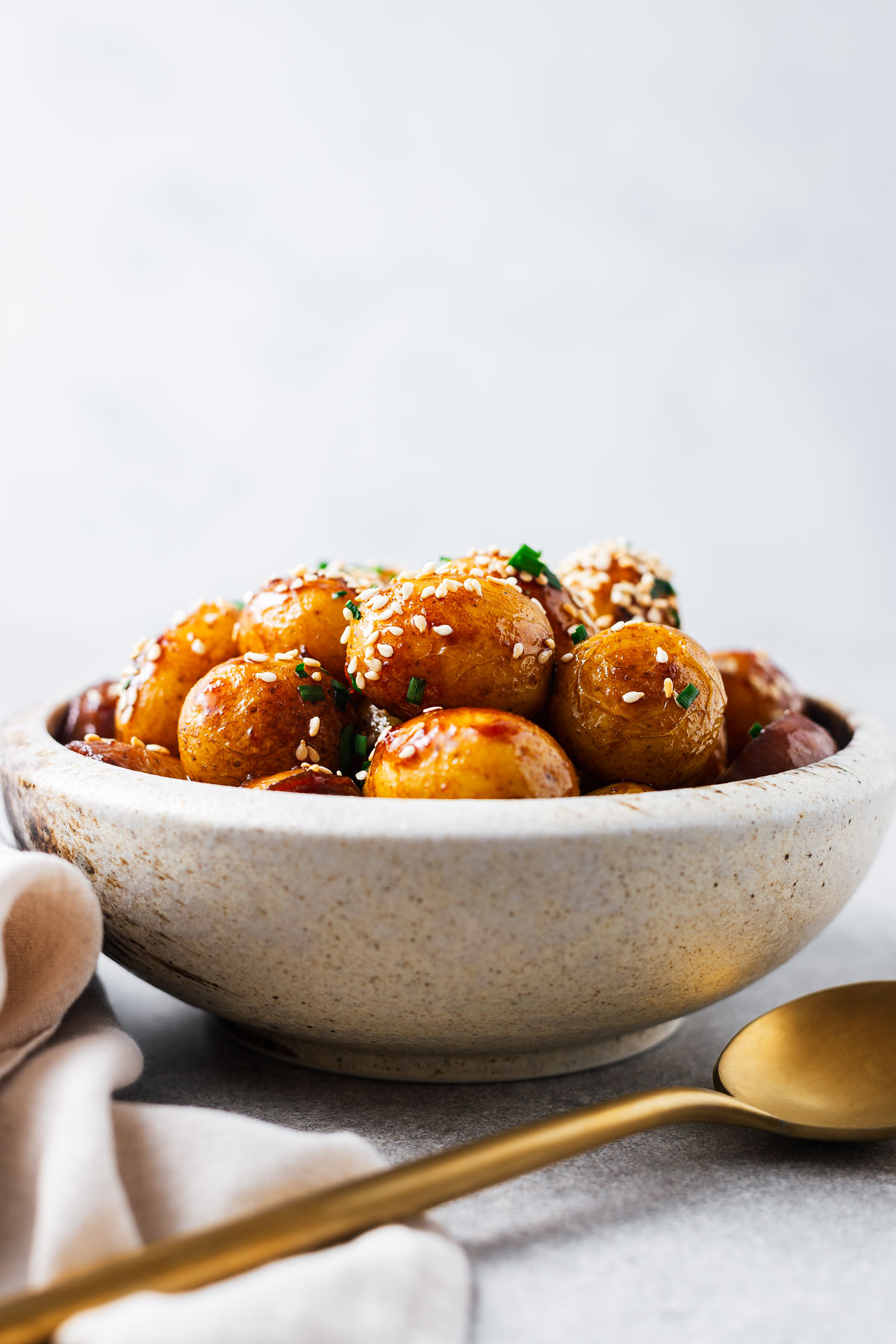
Each piece of potato is soft and fluffy inside, coated in an indulgently sweet and savoury sauce. It’s utterly moreish, to say the least.
The Korean potato recipe is also very flexible.
I provide details for oven roasting, or boiling and sauteing. Use baby potatoes (no peeling needed) or chunks of peeled potato for faster flavour absorption.
Ingredients and substitutes
This simple yet delicious Korean dish requires only a handful of ingredients. And with a few simple substitutes, you can customize this Korean braised potato dish to suit your taste and your pantry.
Best potatoes for braising
The recipe calls for baby potatoes or other small potatoes. I love how the sticky, sweet and intensely savoury sauce clings to the tiny potatoes.
If you can find them, use tiny bite-sized baby potatoes to make algamja jorim. Algamja jorim translates to egg potatoes braised referring to the tiny potatoes that are the size of quail’s eggs.
But you can also use regular-sized potatoes. Waxy potatoes or all-rounders, like Yukon Gold potatoes, work best. Peel and cut them into bite-sized chunks.
Is it best to cut potatoes for gamja jorim or leave them whole?
Cut potatoes absorb more sauce and turn a deep brown colour. They’re soft, flavourful and evenly seasoned with the braising liquid, but also easier to overcook.
Whole baby potatoes take longer to absorb the flavour of the soy braising liquid. But you can braise them for longer without the risk of overcooking.
Baby potatoes are also best if you want to make the braised potatoes well ahead of serving. They don’t soften and turn mushy.
And they’re even better a few hours after cooking, reheated in a covered pan with a splash of water.
I love the whole baby potatoes with the glossy soy sauce coating, but my husband prefers the sliced potatoes that soften and turn dark from the soy. So, I slice any larger potatoes in half to keep the peace in our house.
Let me know which ones you find irresistible in the comments below!
I give the potatoes a headstart by roasting them in olive oil. You can also use vegetable oil or any cooking oil. Or see the gamja jorim recipe notes if you prefer to sauté the potatoes.
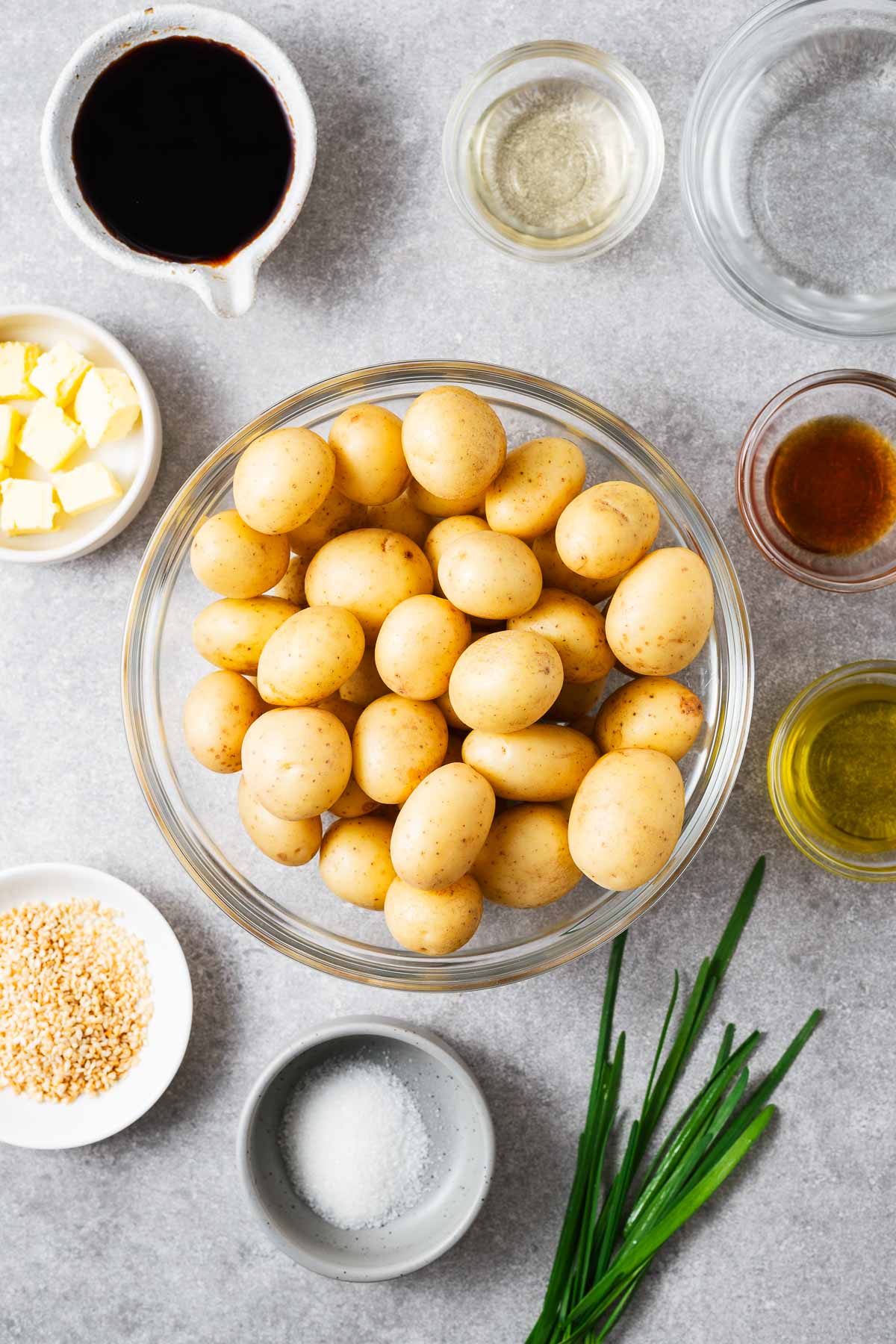
Braising sauce ingredients
You’ll need a few pantry items and Asian staple ingredients for the easy soy-based braising sauce.
- Soy sauce: I use light or all-purpose soy sauce. You can use tamari or coconut aminos as a gluten-free option. Or, for a darker colour, swap half a tablespoon of all-purpose soy sauce for dark soy sauce.
- Mirin: The Japanese rice wine adds sweetness and depth to the sauce. But you can substitute it with rice wine if you prefer the dish less sweet. Or swap it for an extra pinch of sugar or honey instead.
- Sugar: I use white sugar, but you can also use brown sugar, honey, maple syrup, rice syrup or corn syrup.
- Butter: The butter gives the sauce a glossy finish and luxurious flavour. But you can omit it if you want to keep the dish vegan.
- Sesame oil: I love the nutty aroma of toasted sesame oil. But if you don’t have any, you can omit it.
Optional toppings
I love a sprinkle of toasted sesame seeds and chopped chives from the garden.
But you can also try thinly sliced green onions, a sprinkle of gochugaru (Korean chilli flakes), thinly sliced chilli pepper, or furikake rice seasoning.
How to make gamja jorim
Step 1: Preheat oven
Preheat the oven to 430 °F (220 °C) with the oven rack in the centre.
Grab a rimmed baking sheet large enough to fit all the potatoes in a single layer and line it with parchment paper.
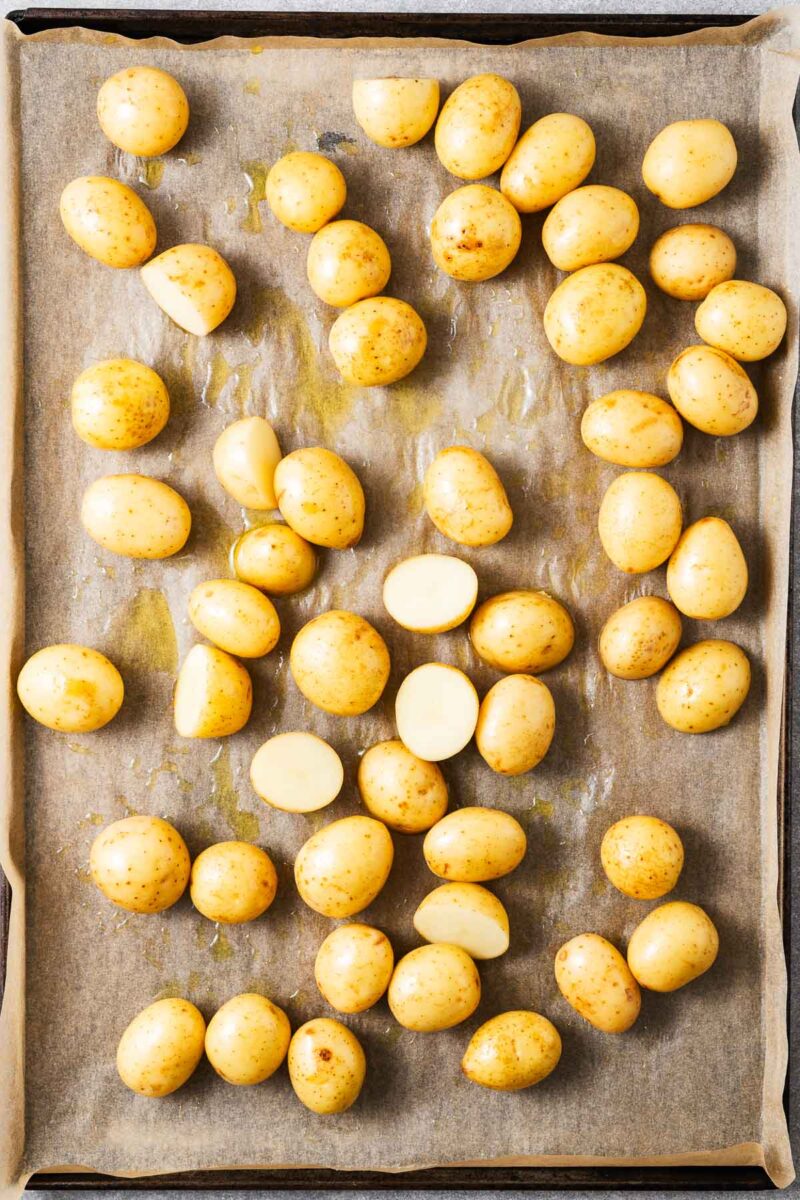
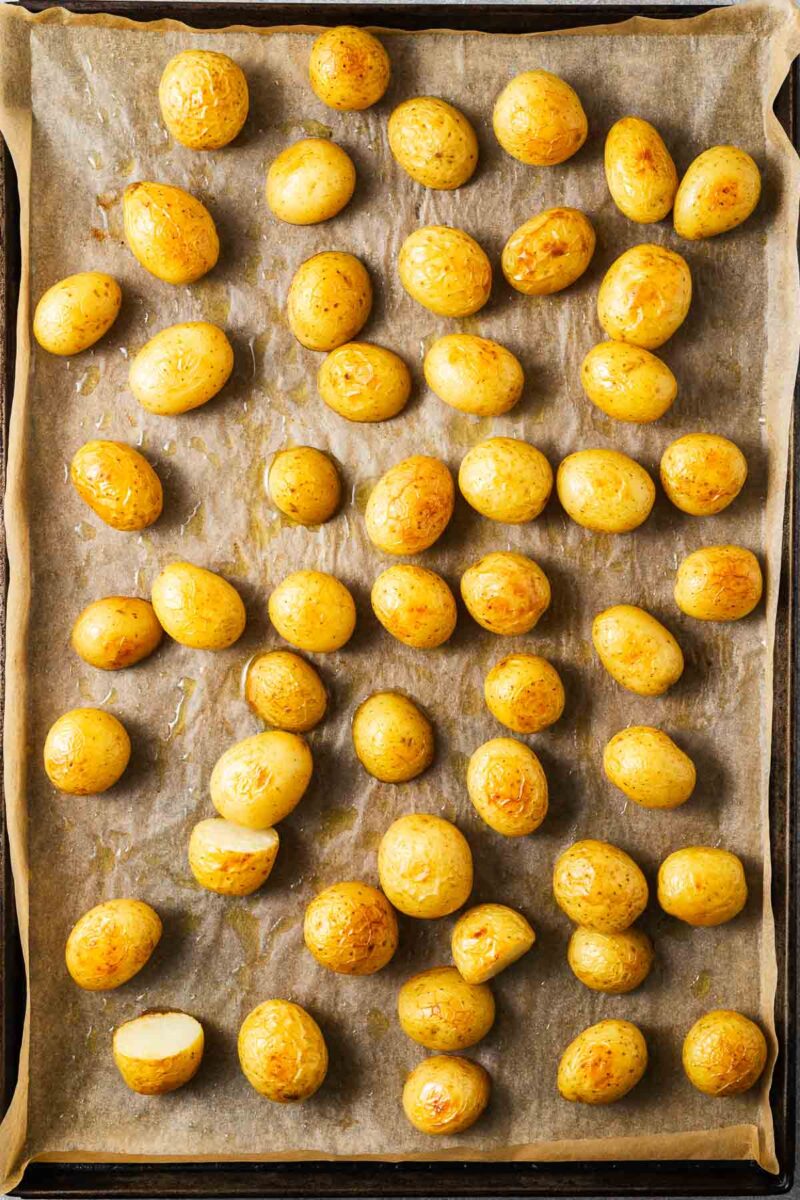
Step 2: Prepare potatoes
Cut your potatoes into bite-sized pieces, or keep small potatoes whole.
With whole potatoes, the glossy sauce clings to the outside of the potato.
But when you slice the potatoes, they absorb more of the sauce for an evenly seasoned braised potato.
I like both, but I prefer the whole baby potatoes. See best potatoes for Korean braised potatoes for more.
Arrange the potatoes on the parchment-lined baking sheet and pour over two tablespoons of olive oil. Use your hands (or a spatula) to roll the potatoes in the oil until evenly coated.
Step 3: Partially cook the potatoes
Roast the potatoes in the hot oven for 15 minutes, then remove the pan and shake or stir to distribute the potatoes and oil evenly.
Return to the oven for another five to ten minutes until golden brown and almost tender.
If you prefer sautéing the potatoes, boil them in lightly salted water until partially cooked. Then add them to a hot pan with the oil and cook for a few minutes to give them some colour. Carefully add the braising liquid to the pan and continue at step five.


Step 4: Make the braising sauce
Meanwhile, combine one cup of water, four tablespoons of soy sauce and two tablespoons of mirin in a frying pan or skillet for which you (preferably) have a lid. The ideal size can hold the potatoes in a single layer.
Cover and let it come to a simmer over medium-high heat.
Step 5: Braise the potatoes
Add the partially cooked potatoes to the simmering braising liquid.
Then turn the heat down low, recover the pan with a lid and cook until the potatoes are soft – about ten minutes.
If you don’t have a lid, you may need to add a splash of water if the pan dries out before the potatoes are tender.

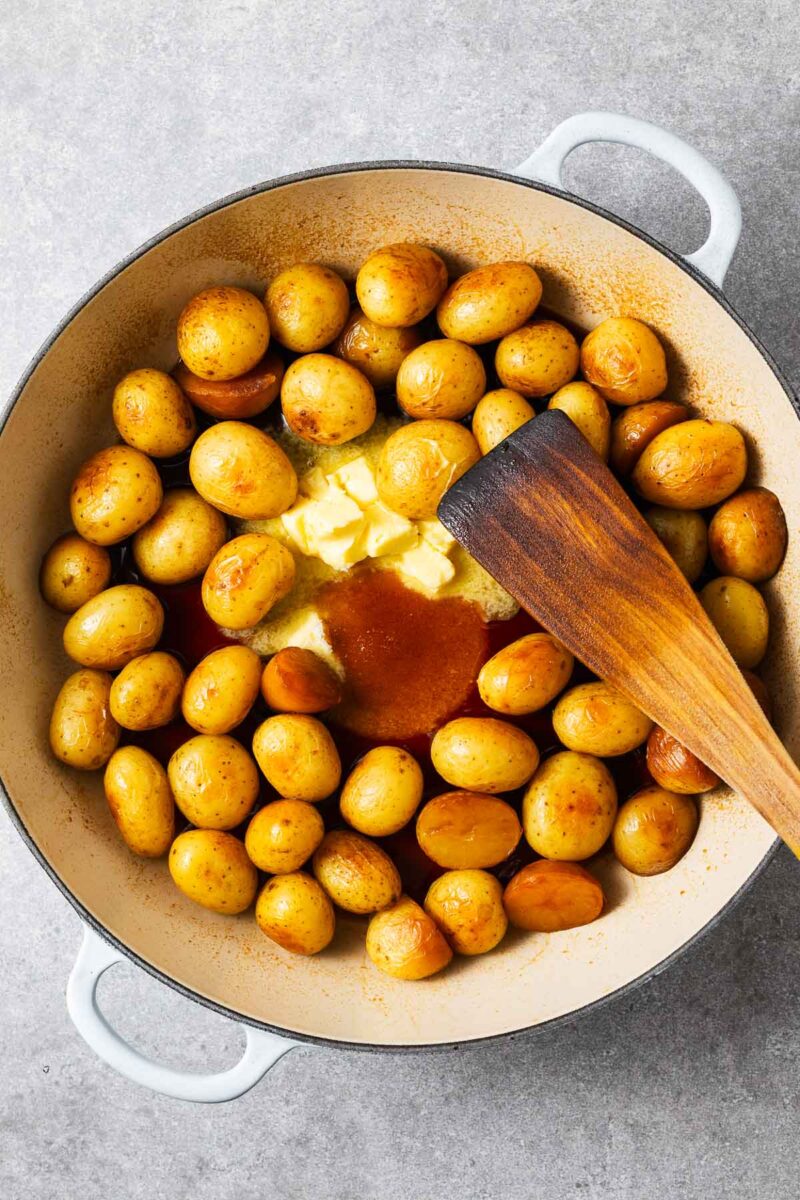
Step 6: Reduce the sauce
Remove the lid and simmer the sauce to reduce until it covers the pan in a thin layer – about five minutes.
Add two tablespoons of unsalted butter and two teaspoons of sugar or honey. Gently stir until the butter emulsifies, the sugar dissolves, and the glossy sauce clings to the potatoes – another minute or two.
Add a splash of water if the sauce is too thick and sticky.
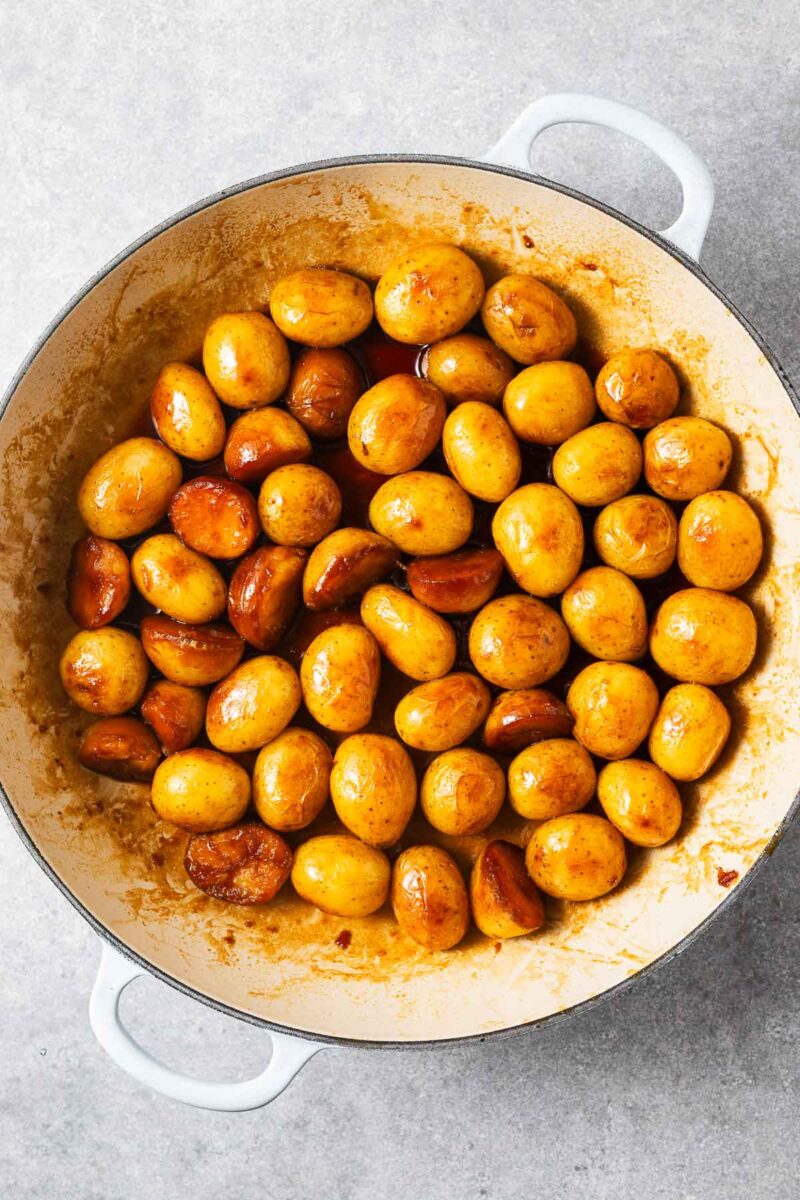

Step 7: Serve the gamja jorim
Remove the pan from the heat and stir through two teaspoons of toasted sesame oil.
Let the potatoes rest in the pan until they reach room temperature, or for at least five minutes if you prefer to serve them warm.
Stir to coat the potatoes in the sauce.
Then, transfer the braised potatoes to a bowl or serving plate and sprinkle with sesame seeds and chives.
Storage and reheating instructions
You can store Korean braised potatoes in the fridge in an airtight container for up to four days.
Whole potatoes will continue absorbing the sweet and savoury flavour. In fact, they’ll taste even better after a few hours of resting in the fridge.
To reheat, add the cold Korean braised potatoes to a pan with a splash of water. Cover with a lid and cook over medium heat until the potatoes are warm.
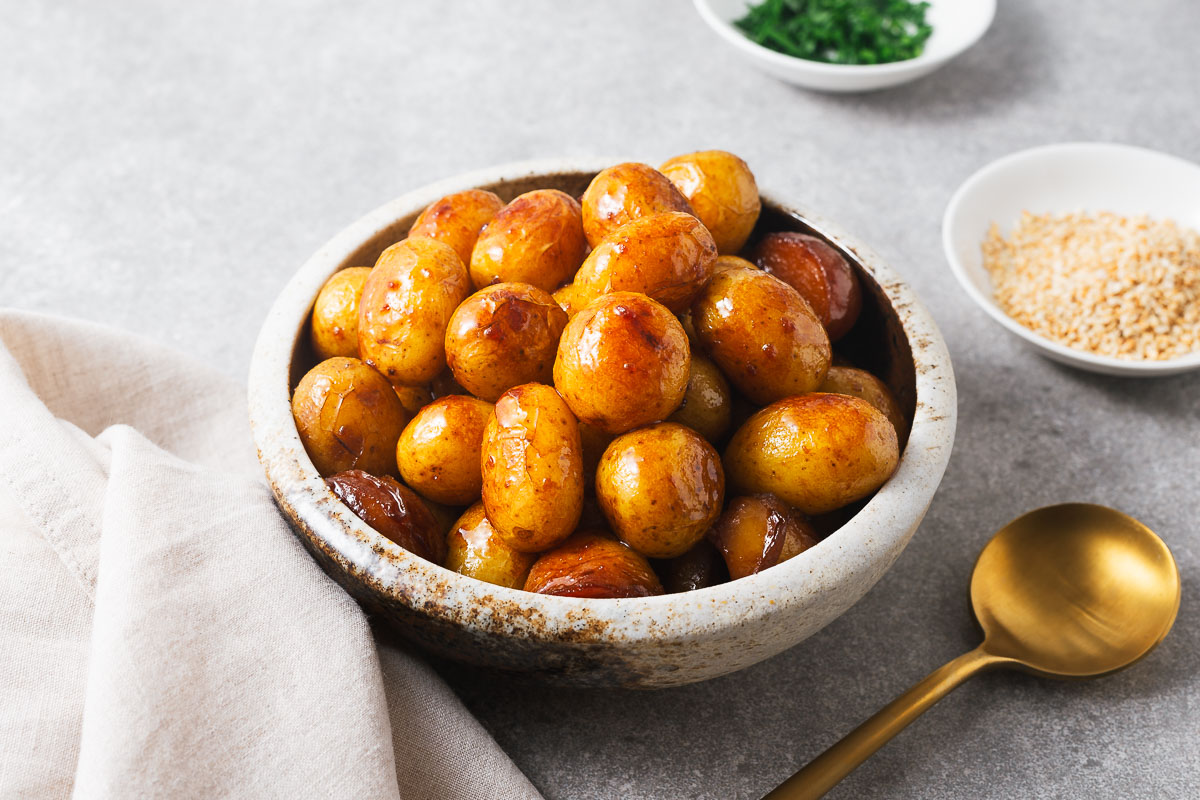
Serving suggestions
While I could seriously snack away at a bowl of these Korean braised potatoes, they also make an excellent side dish.
With a Korean meal: Serve the gamja jorim with other Korean banchan (small plates) like kimchi, oi muchim (spicy cucumber salad), pa muchim (green onion salad), sesame broccoli salad, and gochujang tofu(braised tofu). It’s the perfect spread to complete any Korean meal or Korean BBQ.
As a side dish: These soy-braised baby potatoes make an excellent potato side for summer barbeques and picnics. Swap the sesame seeds and chopped chives for a generous grating of parmesan cheese.
Bibimbap: Enjoy leftover braised potatoes on steamed white rice with any other veggies lurking in the fridge. Top it with a fried egg. Then drizzle generously with spicy bibimbap sauce (made using gochujang paste).
Turn to salad: Turn room-temperature braised potatoes into a Korean-style potato salad. Pinch off the potato skins, then partially mash the potatoes with a fork. Add some thinly sliced cucumber and carrot. Then gently mix in mayonnaise until you’re happy with the flavour. Toss the salad with pieces of chopped boiled egg.
Frequently asked questions
Gamja jorim is a Korean dish of braised potatoes. The potatoes are simmered in a sweet and savoury sauce, and it is often served as a side dish along with more banchan.
Braising is a cooking method that involves simmering food in a liquid, such as broth or sauce. It is a great way to tenderize and flavour potatoes, like in this Korean soy-braised potato recipe.
Gamja is the Korean word for potatoes, and jorim for braising. Gamja jorim translates to braised potatoes. Algamja jorim is braised baby potatoes where the al means egg, referring to how small the potatoes are – like quail’s eggs.
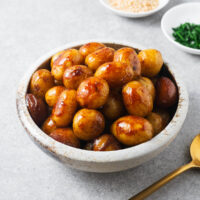
Equipment
- Braiser / Buffet casserole – Or large frying or sauté pan for which you (preferably) have a lid.
Ingredients
- 2 pounds baby potatoes , I prefer small bite-sized potatoes
- 2 tablespoons olive oil
Braising sauce
- 1 cup water
- 4 tablespoons soy sauce
- 2 tablespoons mirin
- 2 teaspoons sugar , or honey
- 2 tablespoons unsalted butter , optional*
- 2 teaspoons toasted sesame oil
To serve (optional)
- 1 tablespoon toasted sesame seeds
- 1 tablespoon chives , finely sliced
Instructions
- Grab a rimmed baking sheet large enough to fit all the potatoes in a single layer and line it with parchment paper. Preheat the oven to 430 °F with the oven rack in the centre. (See notes for stovetop instructions.)
- Keep small potatoes whole and cut potatoes larger than a golf ball in half. Arrange the potatoes on the parchment-lined baking sheet and pour over the olive oil. Use your hands (or a spatula) to roll the potatoes in the oil until evenly coated.
- Roast the potatoes in the hot oven for 15 minutes, then remove the pan and shake or stir to distribute the potatoes and oil evenly. Return to the oven for another 5 to 10 minutes until golden brown and almost tender.
- When the potatoes are almost ready, combine the water, soy sauce and mirin in a frying pan or skillet for which you have a lid*, large enough to fit the potatoes. Cover and let it come to a simmer over medium-high heat. Then tip in the roasted potatoes. Turn the heat down low, recover the pan with a lid and cook until the potatoes are soft – about 10 to 15 minutes depending on the size. (If you don’t have a lid, you may need to add a splash of water if the pan dries out before the potatoes are tender.)
- Remove the lid and simmer the sauce to reduce until it covers the pan in a thin layer – about 5 minutes.
- Add the sugar and butter (if using). Gently stir until the butter emulsifies, the sugar dissolves, and the glossy sauce clings to the potatoes – another 1 or 2 minutes.
- Remove the pan from the heat and stir through the sesame oil. Let the potatoes rest in the pan for at least 5 minutes, or let them cool to room temperature.
- Transfer the braised potatoes to a bowl or serving plate and sprinkle with sesame seeds and chives.
Notes
- The butter gives the sauce a luxurious, glossy finish. But you can omit it for a vegan braised potato dish.
- How you cut your potatoes affects how they absorb the flavour of the sauce. Whole baby potatoes are glossy and salty on the outside but tender and moist on the inside. Cut potatoes are deep brown and savoury throughout, but they’re easier to overcook. See best potatoes for gamja jorim for more.
- If you prefer sautéing the potatoes, boil them in lightly salted water until partially cooked. Then add them to a hot pan with the oil and cook for a few minutes to give them some colour. Carefully add the braising liquid to the pan and continue with the recipe.

I seriously looove these! Sweet and savory, with butter for good measure. Will make again. 🖤
Yay! I’m so happy you enjoyed them, Audrey! I also can’t get enough of these savoury, buttery, soy-glazed potato bites. 😍